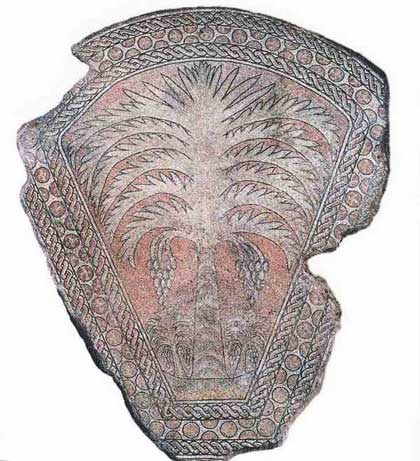5. Archeological Work  5.3 Holy Shrine of Kathisma
5.3 Holy Shrine of Kathisma
5.3 Holy Shrine of Kathisma
Recently, a new Christian shrine was located, partially excavated and identified in the Holy Land. This is the Kathisma, the Seat, of the Holy Virgin, a splendid, huge church of the mid-fifth century AD, possibly the first church to be dedicated to the Theotokos after the third and fourth Oecumenical Councils (of Ephesus and Chalcedon respectively), which established the veneration of Holy Mary following the sharp controversy between Orthodox and Nestorian Christians.
The archaeological excavation of the octagonal church was completed in 2000, and uncovered the Kathisma, with its octagonal ground-plan clearly defined, hundreds of square metres of mosaic flooring, and a number of architectural members in situ.
The Kathisma is located in an olive grove, which belongs to the Greek Orthodox Patriarchate and now adjoins the main Jerusalem-Bethlehem highway. In the level area to the south of it there is a large, now ruined, water cistern, which gives the site its name.
The Arabic name which the cistern has born down the ages is Bir Qadismu or Bir-el-Katisme. Bir means a store of water, i.e. a cistern or spring, qadismu is a corrupt form of the Greek word kathisma, seat. Thanks to this name, which has survived to the present day, the cistern of the seat may be linked to the adjacent Kathisma of the Holy Virgin, which is mentioned in Early Christian sources.
The existence of the monastery of the Kathisma is first mentioned in sixth-century sources by the biographer of St Theodosios the Koinobiarches. The discovery of the church and the monastery in which as it has emerged, exists on the site of the Kathisma came about when a bulldozer accidentally struck the mosaic floor in the north-west part of the octagon. The octagon was uncovered in stages. The west side (adjacent to the highway) came to light first, with the entrance and partially preserved mosaic floors or fragments of mosaic floor decoration and oppus sectile. The focal point of the entire architectural structure is, of course, the Kathisma rock, which was found to be almost flat and projecting a few centimetres above natural ground level.
The octagonal church was built to a plan based on three concentric zones: the inner zone with the Kathisma rock, the middle zone with the ambulatory, both of which have access to the narthex (entrance) on the west side. And the third, outer zone, which includes the four chapels and the polygonal spaces or rooms between them, as may be seen on the ground-plan of the monument based on the investigations so far.
The triple octagonal setting of the precious rock clearly reflects the importance of this sacred spot. The diameter of the inner octagon was probably equal to the height of the octagon up to the drum. It was then roofed with a seemingly conical dome and illuminated by an oculus.
As an architectural monument, the Kathisma seems to have been important not only in terms of its size (it has a surface area of more than 2000 square meters), design, and choice of material, but also as a centre of pilgrimage. It was a local landmark, both as a work of architecture and as the first monument consecrated to the Virgin.
The excavational finds relating to the decoration of the monument are more abundant and perhaps more important, essentially comprising of a large number of mosaics with a variety of geometrical and vegetal motifs and a wide range of colours. The entire surface of the church was decorated with floor mosaics, a large proportion of which (up to 800 square meters), fortunately, has survived.
Another interesting find is the inscription in a floor mosaic in the south-west corner of the excavation, outside the octagonal church. It was apparently surrounded by a simple circular tress in red and black. Part of the tress survives over the upper part of the inscription. The left and the right sides are missing, as is most of the third line. It is done in three colours, black, white and red, and the tesserae are small and of equal size. One interesting movable find from the site is an almost intact censer.





















